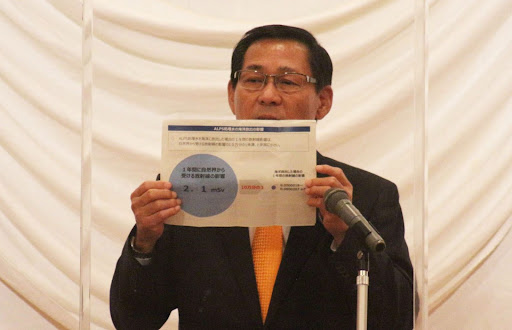Radiation, Reconstruction, Recovery: What the Fukushima Nuclear Incident Means for the Future of Energy

https://www.kojima-toshifumi.jp/report2022.html
Toshifumi Kojima, Liberal Democratic Party Member of the House of Representatives, explains a poster on levels of radiation in the purified wastewater from the Fukushima Daiichi nuclear plant.
We are living through some of the most crucial years for the environmental movement — this is history in the making. Last November, the UN Climate Change Conference took place while the United States Congress and politicians examined their stances on global warming and environmental protection. Energy has never been pure, both in the literal scientific sense to the undeniable affiliation of geopolitical power dynamics in the industry. While this has always been true, recent events have pushed the tension to a breaking point. Japan’s success, or potential lack of it, of efficiently coping with the repercussions of nuclear meltdown is a testament to the viability of nuclear energy as a path to a greener and safer world.
On September 3, 1948, a nuclear reactor successfully generated electricity for the first time in the X-10 graphite reactor in Oak Ridge, Tennessee, USA, marking the beginning of our ongoing mission to harness the power of nuclear energy. As of June 2021, a total of 443 nuclear power plants are in operation in 33 countries around the world, and another 52 are under construction. It has become an undeniable fact that nuclear power generation is an important component of green energy.
However, the high risks of nuclear energy production are also undeniable. The Chernobyl nuclear accident on April 26, 1986 in Ukraine was the first major nuclear power plant accident to be rated as Level 7 by the International Atomic Energy Agency (IAEA), causing 31 immediate deaths. Approximately 100,000 people were evacuated following the accident. Including liquidators and clean-up teams, 1.8 million people in Ukraine, including 377,589 children, have the status of victims of the disaster as of January 2018 with disabilities and death rising in the demographic. Unfortunately, due to the unusually suffocating political environment of Russia? Many details of the aftermath of the Chernobyl nuclear accident have yet to be released, causing the concept of nuclear power to be enwrapped in a cloud of fear and controversy.
Subsequently, the Fukushima Daiichi accident caused by a magnitude 9 earthquake and a following 15-meter tsunami in Fukushima, Japan, on March 11, 2011 was the second major nuclear accident to be rated as a Level 7, with some experts even going so far to label it as potentially more detrimental than the Chernobyl accident. There were explosions leading to leakages of hundreds of thousands of liters of contaminated water. Multiple reactors were leaking in contrast to the singular reactor that had failed in Chernobyl. Official figures show that there have been 2313 deaths related to the nuclear plant meltdown among evacuees.
Due to the serious repercussions of mistakes during nuclear energy production, many countries have brushed it aside and resorted to predominantly relying on resource-rich countries to provide them with energy. In response to the hottest summers in history and the potentially devastating temperature drops that are bound to hit in the coming winters, Russia, the biggest oil exporter globally, ceased its trade of oil due the opposition to its conflict with Ukraine, effectively tightening the chokehold it had on the world. The crucial question now is whether nuclear energy will be the salvation before it’s too late. The efficacy of green energy strategies the world is familiar with like solar panels, wind turbines, and hydropower are heavily confined by geography while their shelf life appears troubling compared to their productivity. Thus, many experts look towards nuclear energy as a fitting universal solution.
So how does Japan play into this global narrative of nuclear energy? The answer is quite simple; mistakes are bound to happen, natural disasters like the earthquake in Fukushima cannot be prevented and human error is another factor that will never be completely dismissed. Hence, to classify the viability of nuclear energy as a long term solution, the worst case needs to be taken care of before we substantially claim it as a fitting solution for the energy crisis. The effects of nuclear meltdowns can be extremely detrimental for decades. Years after the disaster, an estimated 118,000 people who have been evacuated are still sleeping in sports and exhibition halls with an uncertain future. Local businesses are plummeting due to the radiation-exposed environment, leading the workforce to move towards other prefectures for business, leaving behind an aging population on possibly contaminated land.
On October 30th, 2022, I had the great pleasure of attending a political gathering in Tokyo, Japan, where Toshifumi Kojima, Liberal Democratic Party Member of the House of Representatives and State Minister for Reconstruction, discussed his current efforts and future plans to ensure that the wastewater from the Fukushima Daiichi nuclear power plant is safely disposed of and the local communities and economy are adequately revitalized.
Kojima explained that the water goes through ALPS, which stands for Advanced Liquid Processing System (ALPS). It is a multi-nuclide removal system that removes various radioactive materials from contaminated water. In accordance with Japan’s official stance on the issue of wastewater disposal, Kojima described that the level of radiation within water from the Fukushima Daiichi plant is strictly within international regulations and has even been reduced so much so that it would be safe for the human body to consume: according to government analysts, there is an annual consumption of 2.1mSv radiation in drinking water from publicly accepted natural sources, while the radiation in the purified wastewater is only 0.001% of that amount. Kojima carried a bottle of wastewater and drank it himself as a public statement that the water is safe as well as carrying a poster with public data regarding the water.
Treated groundwater also minimally impacts the environment. “When ALPS-treated water is released into the ocean, the radiation impact for one year is very small, less than 1/100,000 of the radiation impact from the natural world,” Kojima explained. “The impact of radiation received from the natural world in one year is 2.1mSv, and the impact of radiation in one year when released into the ocean is 0.0000018-0.0000208mSv.”
When asked about why he carries the poster, he responds by saying, “I carry this piece of paper with me everywhere to help people understand that the water we discharge is safe.”
Another important aspect of Kojima’s program is the revitalization of the local community and economy. One instance of this when he made a guest speech at the opening ceremony of the 2022 Tohoku Reconstruction Processed Seafood Exhibition and Business Meeting 2022” held at the Sendai International Center, and exchanged opinions with exhibitors at the exhibition booth where processed marine products from the area affected by the discharge were introduced at this business meeting and sampled.
Furthermore, Kojima has organized many fairs and markets for people from all across the nation to visit and indulge in local products. One example of this is the Fukushima Reconstruction Fair which was held with the cooperation of Fukushima Prefecture, with the aim of supporting recovery by promoting the consumption of commodities. While listening to the stories from the people affected by the incident, customers were also to purchase various products from Fukushima prefecture that were lined up at the booths.
Moreover, the local population has seen a drastic demographic shift due to the amount of youth leaving to pursue better work in other areas of Japan such as Tokyo. This phenomenon leaves the elderly particularly susceptible to mental illnesses such as depression or anxiety due to prolonged periods of isolation.
“There are still many lonely old people in the disaster-stricken areas,” Kojima noted. “I went to the local area to conduct field research and found that loneliness within the elderly male population is very high. Unlike elderly women who have friends and family members they can talk to via telecommunication, and it is difficult for men to take the initiative to talk to friends or family members. This leads to psychological problems remaining unrelieved, and they are more likely to have various psychological problems.”
In order to solve this problem, Kojima looked to his children for solutions. He notices they spend many hours on their computers and have even made “online friends” who, more often than not, meet online and sustain the friendship online. This inspired him to create a similar community for the elderly in affected regions.
“We are now promoting platforms such as Skype,” he announced. “With the help of government officials who can set up and instruct the usage of such apps, we can use remote connections to help the elderly eliminate loneliness.”
The true impact of Japan’s nuclear plant incident is not only limited to local affected regions, but it is also a global trial to assess the possibility of pursuing nuclear energy as an effective energy source, and moreover, a safe alternative that we can attempt to prevent to the best of our abilities and successfully contain the damages if incidents like this occur in the future. Japan’s Fukushima Daiichi accident certainly had negative consequences, causing deaths and displacement while affecting local affected regions. Yet, as Kojima explained, it now also serves an important positive role, providing a model for successfully containing nuclear damages if similar incidents occur.

